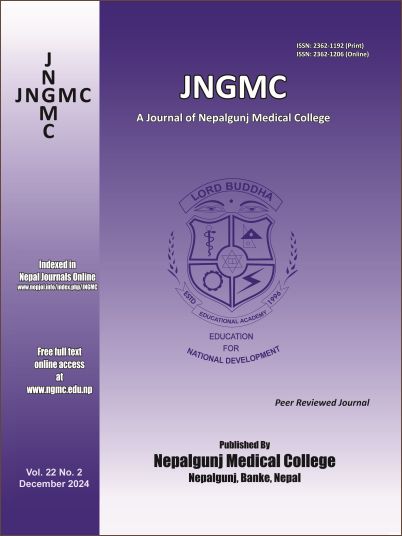Evaluation of the Impact of Helmet Use on the Severity of Traumatic Brain Injury
DOI:
https://doi.org/10.3126/jngmc.v22i2.74348Keywords:
Traumatic brain injury, helmet use, Glasgow Coma Scale, motorcyclists, Nepal, injury preventionAbstract
Introduction: Traumatic brain injuries are a leading cause of morbidity and mortality among motorcyclists, especially in Nepal, where two-wheeler vehicles are highly prevalent. This study investigates the association between helmet use and the severity of traumatic brain injuries in motorcyclists presenting to a tertiary care hospital.
Aims: To evaluate the impact of helmet use on the severity of traumatic brain injuries and associated clinical outcomes.
Methods: A prospective cohort study was conducted on 150 motorcyclists admitted to Kathmandu Medical College Teaching Hospital between July and September 2023. Data on demographic and clinical characteristics, including age, gender, mechanism of injury, alcohol or drug use, and injury severity, were collected. The Glasgow Coma Scale scores and imaging findings were analyzed to assess traumatic brain injury severity. Statistical tests, including chi-square and logistic regression, were employed to evaluate the association between helmet use and injury outcomes.
Results: Among 150 participants, 87 (58%) were helmeted, and 63 (42%) were non-helmeted. The mean age was 32.8 years (SD = 11.2). Helmeted patients had significantly higher Glasgow Coma Scale scores (13.2 vs. 8.4, p < 0.001) and were more likely to experience mild or moderate traumatic brain injuries (90%) compared to non-helmeted patients, who had a higher proportion of severe injuries (60%). Imaging revealed that helmeted patients had a lower incidence of intracranial hemorrhage (25% vs. 75%) and contusions (15% vs. 60%) (p < 0.001).
Conclusion: Helmet use significantly reduces the severity of traumatic brain injuries, as evidenced by higher Glasgow Coma Scale scores, lower intracranial hemorrhage rates and reduced likelihood of severe injuries. These findings emphasize the need to promote helmet use to mitigate the burden of traumatic brain injuries in Nepal.
Downloads
Downloads
Published
How to Cite
Issue
Section
License
Copyright (c) 2024 Journal of Nepalgunj Medical College

This work is licensed under a Creative Commons Attribution-NonCommercial-NoDerivatives 4.0 International License.
- Attribution - You must give appropriate credit, provide a link to the license, and indicate if changes were made. You may do so in any resonable manner, but not in any way that suggests the licensor endorses you or your use.
- Non Commercial- The materials cannot be used for commercial purposes.
- No Derivatives- If the material is remixed or transformed or built upon, the modified material cannot be distributed.




